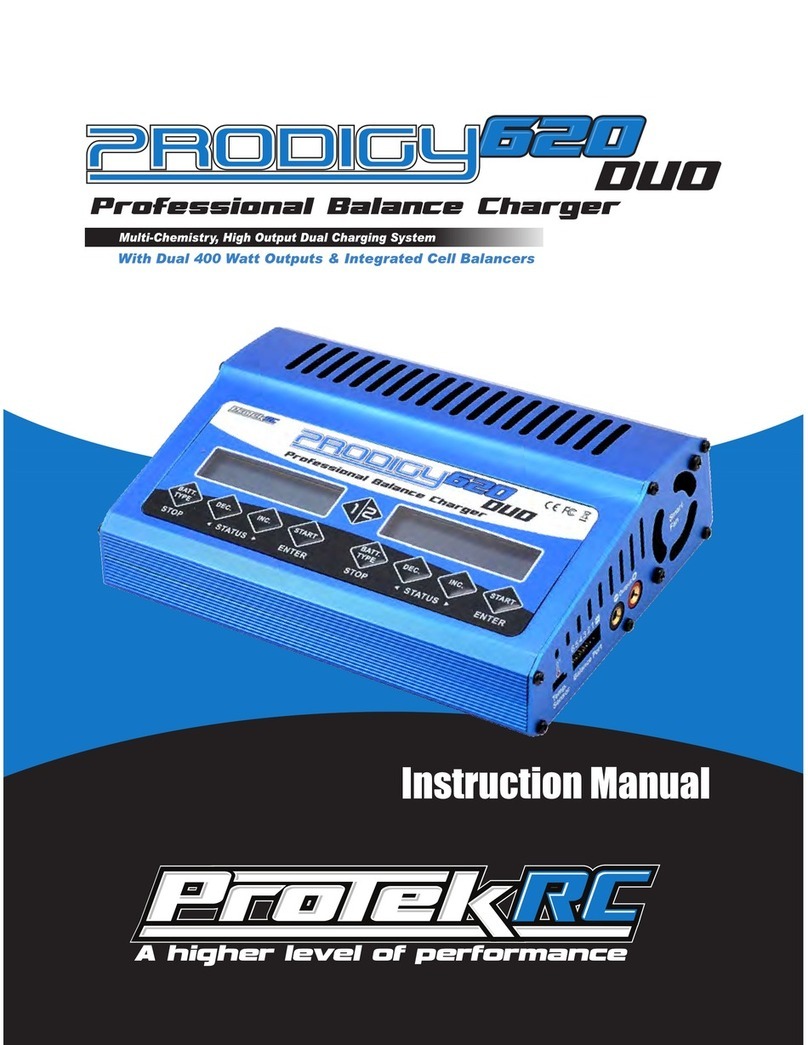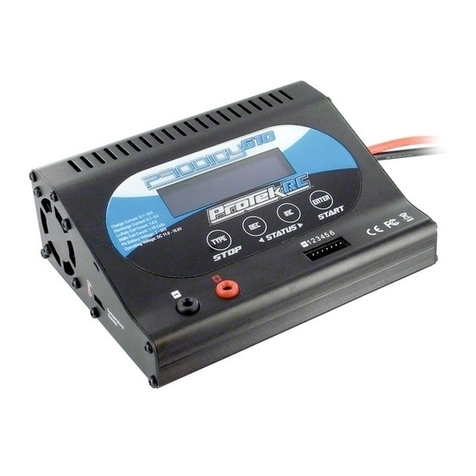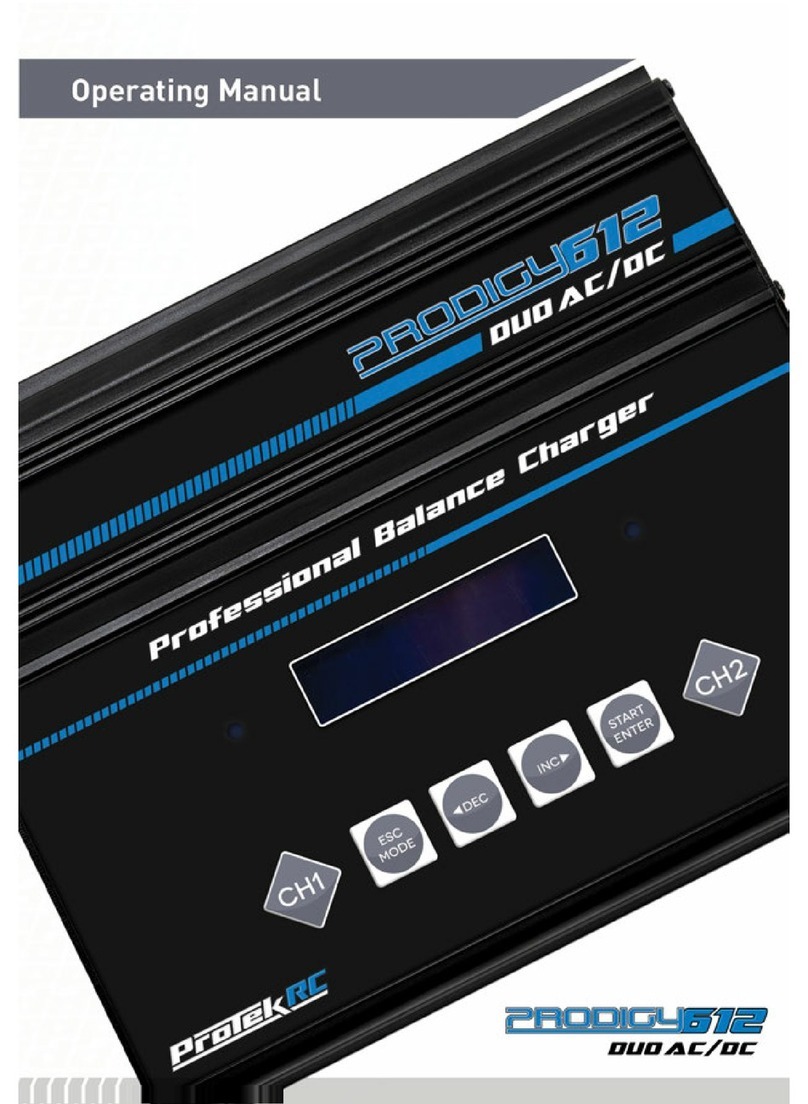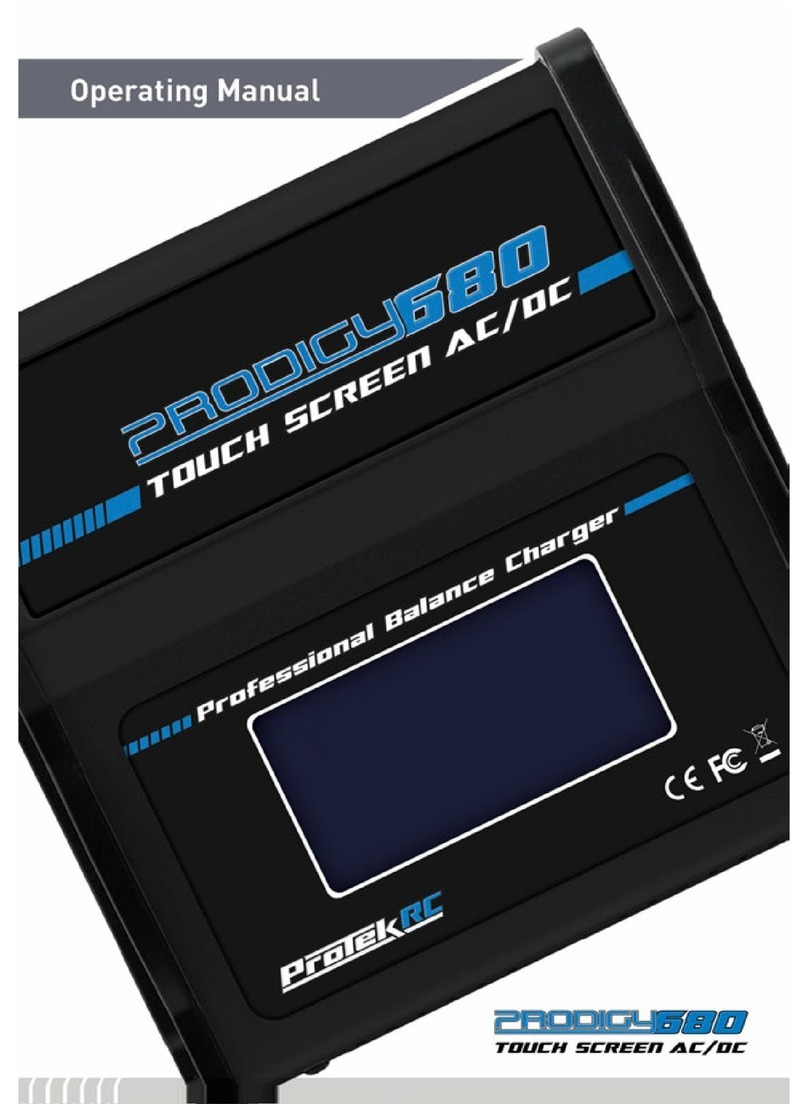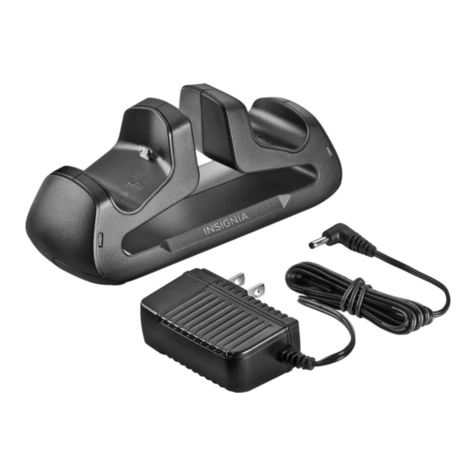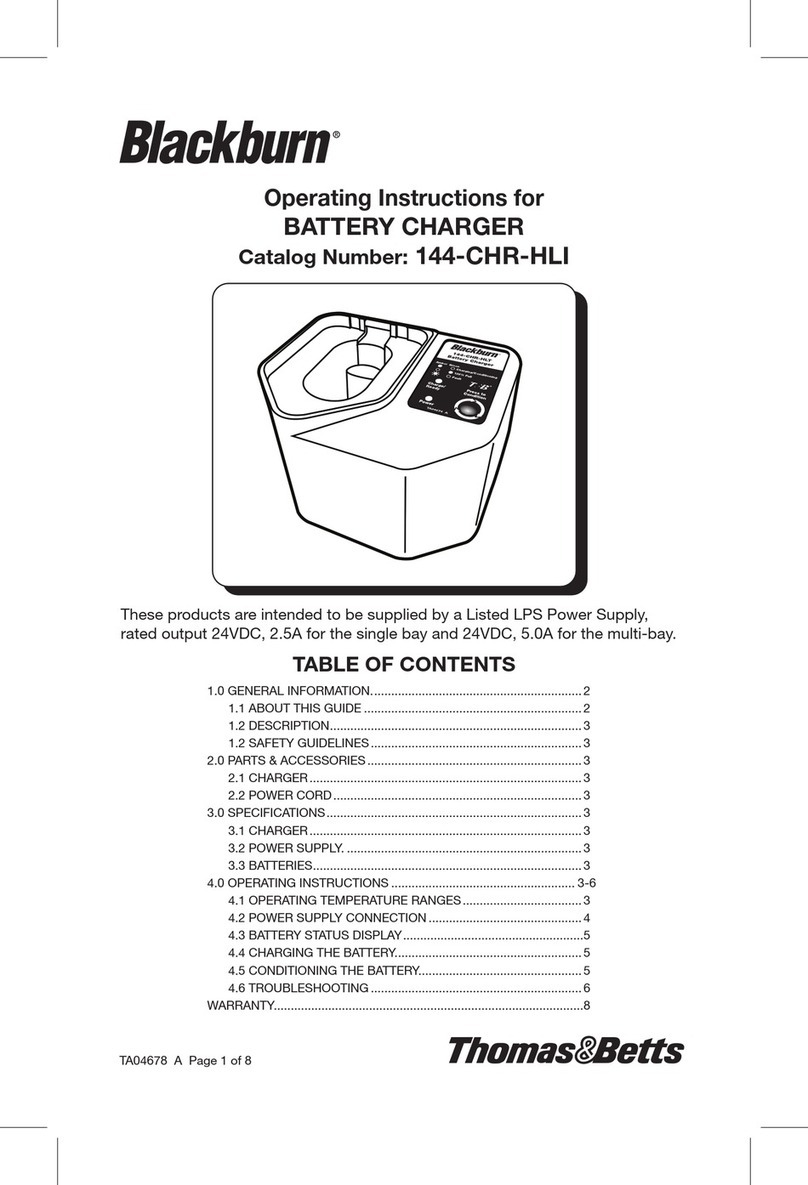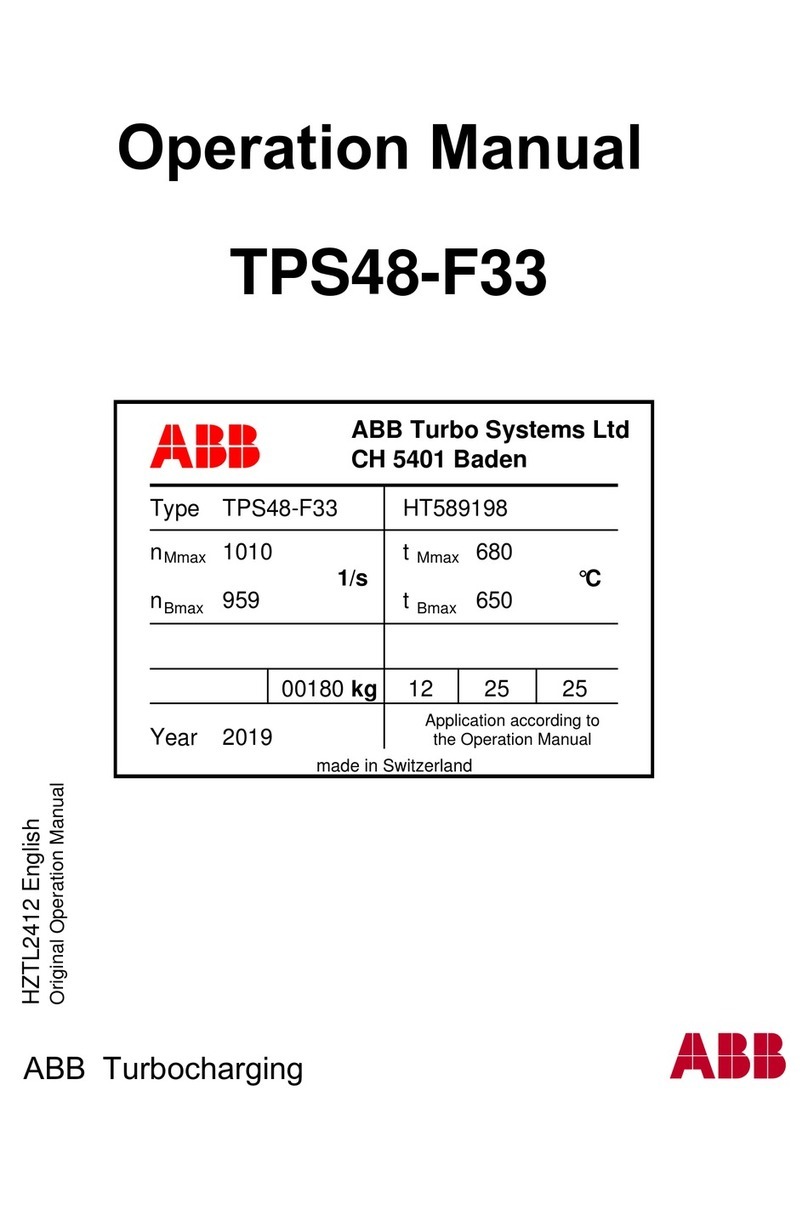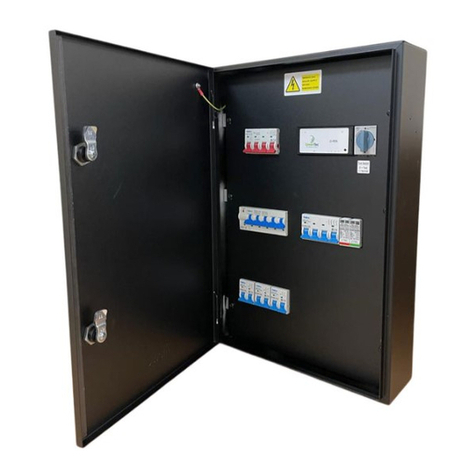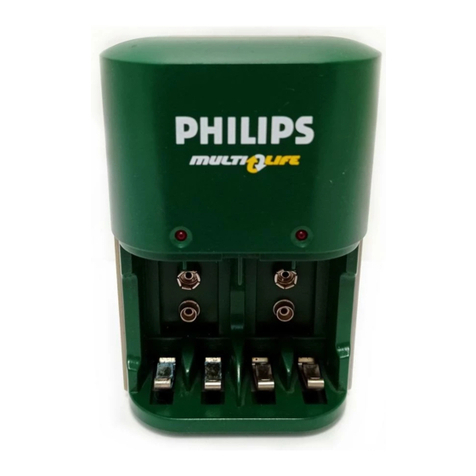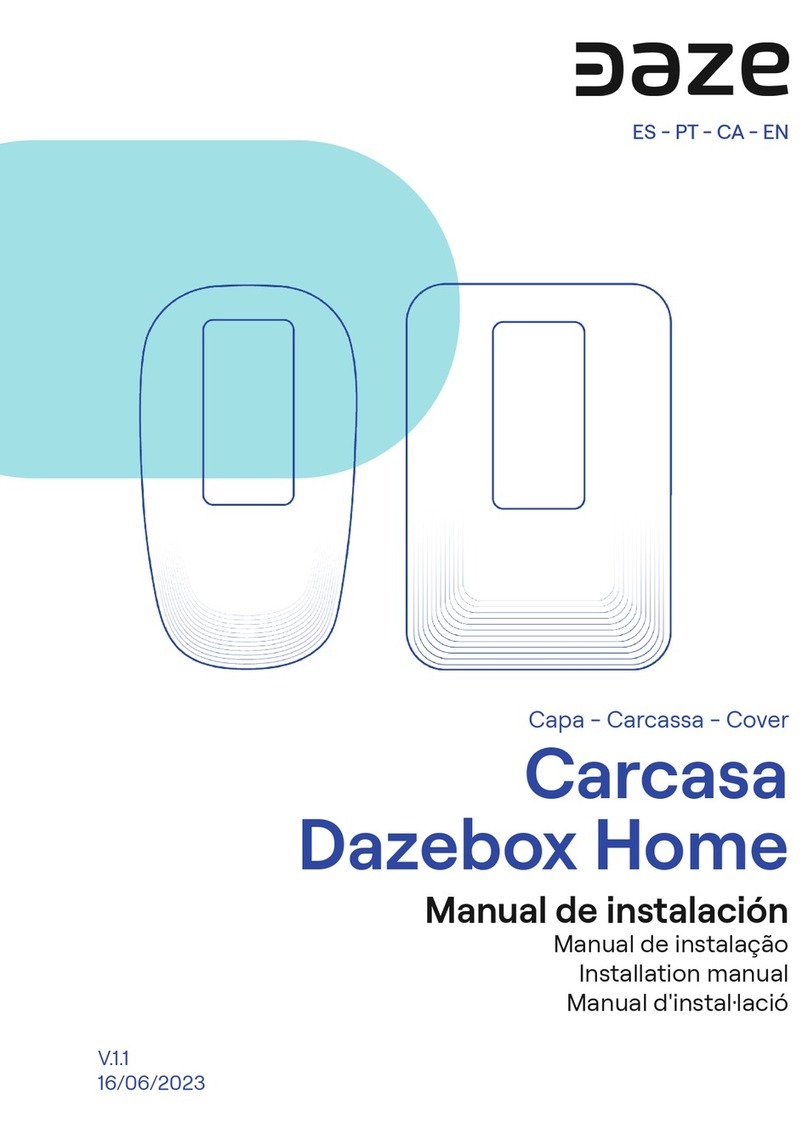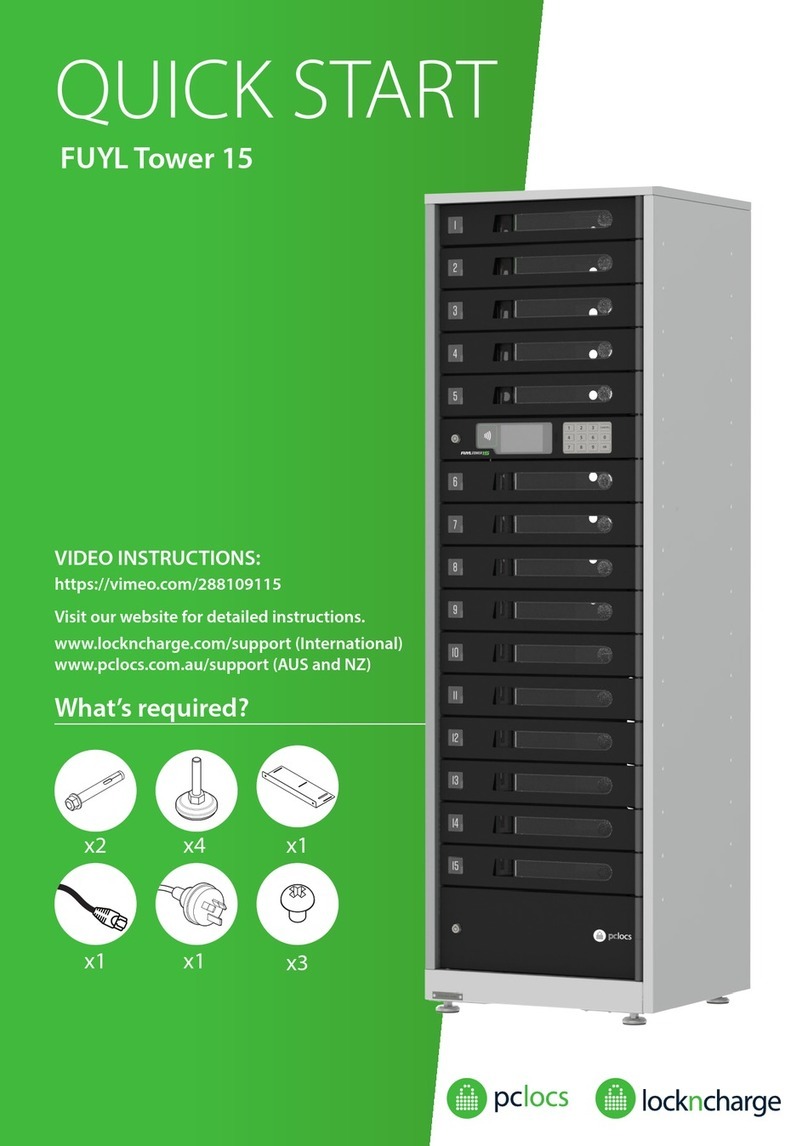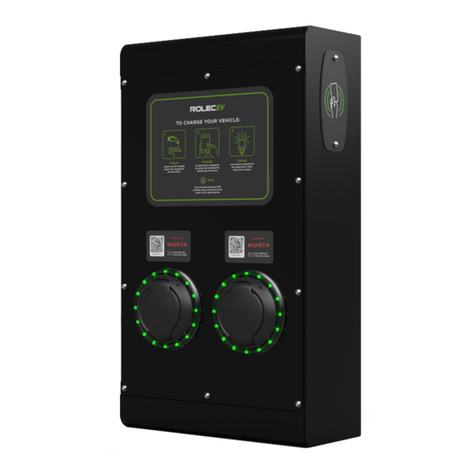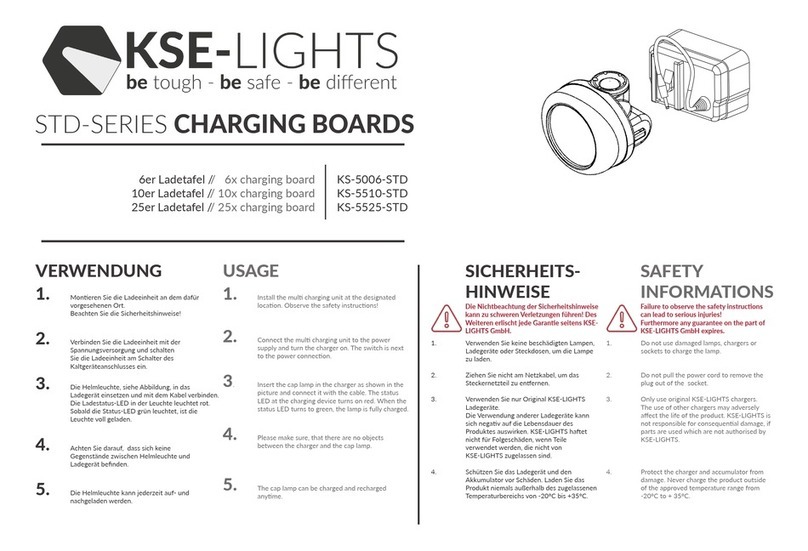Protek RC Prodigy 610 DUO User manual

Manufactured by ProTek R/C
Multi-Chemistry, High Output Dual Charger System
With Dual 200Watt Outputs & Integrated Cell Balancers
All specifications and figures are subject to change without notice.
Printed in China © 2010 © Protek R/C 2010 Version 1.0

01 02
LCD Screen
PC Link Socket USB Power Supply 5V/1A
Output 1
Balancing Port
Output 2
Balancing Port
Temperature
Sensor
Type/Stop Button
Select Wheel
(Rotary Control)
INC/DEC
Button Enter/Start
Button
Capacitive Touch
Button System
Output 1 LED
Output 2 LED
TABLE OF CONTENTS
Introduction .................................................................................................................... 02
Special Features ............................................................................................................ 05
Warning and Safety Notes.............................................................................................. 09
Program Flow Chart ...................................................................................................... 14
Lithium Polymer Balance Charge Program Connection Diagram .................................. 16
Initial Parameter Setup (User’s Setup) .......................................................................... 18
Lithium Battery (Lilo/LiPo/LiFe) Program ...................................................................... 21
Charging Lithium Battery in the Charge Mode .............................................................. 22
Charging Lithium Battery in the Balance Mode.............................................................. 23
Charging Lithium Battery in the Fast Charge Mode ...................................................... 24
Charging Lithium Battery in the Storage Mode .............................................................. 25
Discharging of Lithium Battery ...................................................................................... 26
Charging NiCd/NiMH Battery in the Charge Mode ........................................................ 27
Discharge of NiCd/NiMH Battery.................................................................................... 28
Charge/Discharge and Discharge/Charge Cycle of NiCd/NiMH Battery........................ 29
Charging Pb (lead-acid) battery in the Charge Mode .................................................... 30
Discharging of the Pb Battery ........................................................................................ 31
Storage Data Program .................................................................................................. 32
Load Data Program........................................................................................................ 33
Various Information in the Program................................................................................ 34
Warning and Error Message .......................................................................................... 35
Recommended Accessories .......................................................................................... 36
Conformity Declaration .................................................................................................. 37
Maximum Circuit Power Chart........................................................................................ 38
Specification .................................................................................................................. 40
Commonly Used Terms.................................................................................................. 41
Warranty and Service .................................................................................................... 42
INTRODUCTION
Congratulations on your choice of the Prodigy 610 Duo digital intelligent charger
from ProTek R/C. You are now the owner of a professional charger/discharger with
battery management and integral balancer.
Temperature
Controlled Fan
DC Input 11V~18V
Select Button,
Output1/2

03 04
INTRODUCTION SPECIAL FEATURES
Please read this entire operating manual completely and attentively before using
this product, as it covers a wide range of information on operating and safety.
The unit is simple to use, but the operation of a sophisticated automatic charger/
discharger such as the Prodigy 610 Duo does require some knowledge on the part of
the user. These operating instructions are designed to ensure that you quickly
become familiar with its functions.
It is therefore important that you thoroughly read the Operating Instructions and Warning
and Safety Notes before you attempt to use your new automatic charger for the first time.
We hope you have many years of pleasure and success with your new battery charger.
The Prodigy 610 Duo employs the circuit that features dual output power of 200 watts each.
Total output power are 400 Watts. Each output can charge or discharge up 18 cells
of NiCd/NiMH or 6 series of Lithium batteries with maximum current of 10A. Prodigy 610
Duo has an individual cell voltage balancer, so it does not required any balancer
separately when charging Lithium batteries (LiPo/LiIon/LiFe) for voltage balancing.
More reliable/durable capacitive touch systems are using for charger controls. With no
moving parts to wear out, the wear and tear issues which plague conventional switches
are inherently eliminated. Additionally, because capacitive touch buttons are mounted
behind solid substrates, user and environmental abuse become a non-factor.
The three capacitive touch buttons and the Select Wheel are multi-function charger
controls, as indicated by the printed legends. The Select Wheel has three functions:
1. Rotate to the right: This action change the functions of charger or increase the value
of charger s parameters.
2. Rotate to the left: This action change the functions of charger or decrease the
value of charger s parameters.
3. Holding + or button pressed in produces a continuous change. Holding the
button pressed in for a long period accelerates the rate of change.
The fan cooling system is so smart and efficiently. The fan speed is controlled by
internal temperature sensor.
Please BE SURE to read these instructions and Warning and Safety Notes before
you use the charger for the first time.
It can be dangerous to mis-handle batteries and battery chargers, as there is
always a risk of batteries catching fire and exploding.
Set contents
Special Features
Optimized operating software
The Prodigy 610 Duo features the so-called AUTO function that set the feeding current
during the process of charging or discharging. Especially for Lithium batteries, it
can prevent the overcharging which may lead to an explosion due to the user's
fault. It can disconnect the circuit automatically and alarm once detecting any
malfunction. All the programs of this product were controlled through two way
linkage and communication, to achieve the maximum safety and minimize the
trouble. All the settings can be configured by users!
Internal independent lithium battery balancer
The Prodigy 610 Duo employs an individual-cell-voltage balancer. It isn’t necessary to
connect an external balancer for balance charging.
Balancing individual cells battery discharging
During the process of discharging, the Prodigy 610 Duo can monitor and balance each
cell of the battery individually. Error message will be indicated and the process
will be ended automatically if the voltage of any single one cell is abnormal.
1. Prodigy 610 Duo Charger 5. Temperature Probe
2. XH Adaptor x 2Sets 6. Crocodile Clip Charging Cable
3. Charger Monitor Program Disk 7. 18AWG Wire Charging Cable x 2Pcs
4. USB Cable 8. Plug-in Battery Clamps

05 06
Adaptable to various type of lithium battery
The Prodigy 610 is adaptable to various types of lithium batteries, such as Li-ion,
LiPo and the new LiFe series of batteries.
Fast and storage mode of lithium battery
There are several modes of charging available, ‘Fast’ charge will reduce the duration of
charging, while ‘store’ state can be used when you are not planning to use the batteries
for several days. This will protect and exend the useful life of your batteies.
Maximum safety
Delta-peak sensitivity: The automatic charge termination program based on the
principle of the Delta-peak voltage detection. When the battery's voltage exceeds
the threshold, the process will be terminated automatically.
Automatic charging current limit
You can set up the upper limit of the charging current when charging your NiCd or
NiMH battery; it is useful for the NiMH battery of low impedance and capacity in the
'AUTO' charging mode.
Capacity limit
The charging capacity is always calculated as the charging current multiplied by
time. If the charging capacity exceeds the limit, the process will be terminated
automatically when you set the maximum value.
Temperature threshold
The battery’s internal chemical reaction will cause the temperature of the battery
to rise. If the temperature limit is reached, the process will be terminated. This
function is available by connecting temperature probe, which is included in the
package.
Processing time limit:
This will limit the maximum process time allowed to charge or discharge.
Data store/load
For users convenience it can store preset information on a maximum of 10 different
settings. You can establish the program settings of the battery to charge or
discharge. These, settings can be quickly recalled at any time.
Cyclic charging/discharging
1 to 5 cyclic and continuous process of charge>discharge or discharge>charge is
operable for battery refreshing and balancing to stimulate the battery’s activity.
SPECIAL FEATURES SPECIAL FEATURES
PC based analysis using USB Communication (For output 1 only.)
The Prodigy 610 Duo is fitted with a mini USB port on the front side of the case;
a USB wire can be connected to this socket in order to link the charger to a PC.
“Charger Monitor” program enables you to view graphs of charge and discharge curves,
with a capacity, voltage, temperature and ampere display, and individual curves can be
individually suppressed or superimposed to allow a visual comparison of the data.
PC based analysis using USB Communication
USB Power Supply
The USB power supply can provide 5V, 1A continue current. You can power your
mobile phone, digital camera or even your IPod via the USB power supply.

07 08
Never leave the charger unattended when it is connected to its power supply. If any
malfunction is found, TERMINATE THE PROCESSAT ONCE and refer to the
operation manual.
WARNING AND SAFETY NOTES WARNING AND SAFETY NOTES
These warnings and safety notes are particularly important. Please follow the
instructions for maximum safety; otherwise the charger and the battery can be
damaged or at worst it can cause a fire.
Keep the charger well away from dust, damp, rain, heat, direct sunshine and vibration.
Never drop it.
The allowable input voltage is 11~18V DC
This charger and the battery should be put on a heat-resistant, noninflammable and
nonconductive surface. Never place them on a car seat, carpet or similar.
Keep all the inflammable volatile materials away from operating area.
Make sure you know the specifications of the battery to be charged or discharged to ensure it
meets the requirements of this charger. If the program is set up incorrectly, the battery and
charger may be damaged .It can cause fire or explosion due to overcharging. This warranty is
not valid for any damage or subsequent damage arising as a result of a misuse or failure to
observe the procedures outlined in this manual.
LiPo LiIon LiFe NiCd NiMH Pb
Nominal 3.7V/cell 3.6V/cell 3.3V/cell 1.2V/cell 1.2V/cell 2.0V/cell
Voltage
Max Charge 4.2V/cell 4.1V/cell 3.6V/cell 1.5V/cell 1.5V/cell 2.46V/cell
Voltage
Storage 3.8V/cell 3.7V/cell 3.3V/cell n/a n/a n/a
Voltage
Allowable 1C 1C 4C 1C-2C 1C-2C 0.4C
Fast Charge
Min. Discharge 3.0V/cell 2.5V/cell 2.0V/cell 0.85V/cell 1.0V/cell 1.75V/cell
Voltage
Standard Battery Parameters
Be very careful to choose the correct voltage for different types of battery otherwise
you may cause damage to the batteries. Incorrect settings could cause the cells to
fire or explode.
Never attempt to charge or discharge the following types of batteries.
• A battery pack which consists of different types of cells (including different
manufacturers)
• A battery that is already fully charged or just slightly discharged.
• Non-rechargeable batteries (Explosion hazard).
• Batteries that require a different charge technique from NiCd, NiMh, LiPo
or Gel cell (Pb, Lead acid).
• A faulty or damaged battery.
• A battery fitted with an integral charge circuit or a protection circuit.
• Batteries installed in a device or which are electrically linked to other components.
• Batteries that are not expressly stated by the manufacturer to be suitable for
the currents the charger delivers during the charge process.
Please bear in mind the following points before commencing charging:
• Did you select the appropriate program suitable for the type of battery you
are charging?
• Did you set up adequate current for charging or discharging?
• Have you checked the battery voltage? Lithium battery packs can be wired in
parallel and in series, i.e. a 2 cell pack can be 3.7V (in parallel) or 7.4V (in series).
• Have you checked that all connections are firm and secure?
• Make sure there are no intermittent contacts at any point in the circuit.
Charging
During charge process, a specific quantity of electrical energy is fed into the battery. The
charge quantity is calculated by multiplying charge current by charge time. The maximum
permissible charge current varies depending on the battery type or its performance, and can
be found in the information by the battery manufacturer. Only batteries that are expressly
stated to be capable of quick-charge are allowed to be charged at rates higher than the
standard charge current.
Connect the battery to the terminal of the charger: red is positive and black is
negative. Due to the difference between resistance of cable and connector, the
charger can not detect resistance of the battery pack, the essential requirement
for the charger to work properly is that the charge lead should be of adequate
conductor cross-section, and high quality connectors which are normally goldplated
should be fitted to both ends.
Always refer to the manual by the battery manufacturer pertaining to charging
methods, recommended charging current and charging time. Especially, the
Lithium battery should be charged according the charging instruction provided
by the manufacturer strictly.

09 10
WARNING AND SAFETY NOTES PROGRAM FLOW CHART
Attention should be paid to the connection of Lithium battery especially.
Do not attempt to disassemble a battery pack!
Please be aware that Lithium battery packs can be wired in parallel and in
series. In the parallel connection, the battery’s capacity is calculated by
multiplying single battery’s capacity by the number of cells with total voltage
stay the same. The voltage’s imbalance may cause fire or explosion .Lithium
battery is recommended to charge in series.
Discharging
The main purpose of discharging is to clean residual capacity of the battery, or to reduce
the battery’ voltage to a defined level. The same attention should be paid to the discharging
process as charging. The final discharge voltage should be set up correctly to avoid deep
discharging. Lithium battery can not be discharged to lower than the minimum voltage, or it
will cause a rapid loss of capacity or a total failure. Generally, Lithium battery doesn’t need
to be discharged. Please pay attention to the minimum voltage of Lithium battery to protect
the battery.
Some rechargeable batteries have a memory effect. If they are partly used and recharged
before the whole charge is accomplished, they remember this and will only use that part
of their capacity next time. This is a ‘memory effect’It is said that NiCd and NiMH batteries
are suffering from memory effect. NiCd has more memory effect than NiMH.
Lithium batteries are recommended to be discharged partially rather than fully discharged.
Frequent full discharging should be avoided if possible. Instead, charge the battery more
often or use a battery of larger capacity. Full capacity cannot be reached until it has been
subjected to 10 or more charge cycles. The cyclic process of charge and discharge will
optimize the capacity of battery pack.

11 12
4mm Bullet Connectors
plugging to power
supply directly
Using terminal
clip attaching to
car battery
LITHIUM POLYMER BALANCE CHARGE PROGRAM
CONNECTION DIAGRAM
CONNECTING THE CHARGER
The Prodigy 610 comes with male 4mm Bullet connectors attached to the power INPUT
cables. These cables are appropriate for attaching directly to most high-qualityAC-DC
power supply units, such as ProTek R/C Super Pro 40 (13.8V, 40A). Also included are
large Terminal Clips with matching 4mm female bullet connectors, for attaching directly
to 12V car batteries. It is critically important that you use either a fully charged 13.8 car
battery or a high quality AC-DC power supply in the range of 11V~18V DC output, with
minimum current rating of 20A to insure reliable performance.
CONNECTING THE BATTERY
Important! Before connecting a battery it is absolutely essential to check one last time
that you have set the parameters correctly. If the settings are incorrect, the battery may
be damaged, and could even burst into flames or explode. To avoid short-circuits between
the banana plugs, always connect the charge leads to the charger first, and only then to
the battery. Reverse the sequence when disconnecting the pack.
LITHIUM POLYMER BALANCE CHARGE PROGRAM
CONNECTION DIAGRAM
Balance socket:
The balance wire attached to the battery must be connected to the charger with the
black wire aligned with the negative marking. Take care to maintain correct polarity!
(Wiring diagram: see below.)
This diagram shows the correct way to connect your battery to the Prodigy 610 while
charging in the balance charge program mode only.
Failure to connect as shown in this diagram will damage this charger.
To avoid short circuit between the charge lead always connect the charge cable to
the charger first, then connect the battery. Reverse the sequence when disconnecting.
WARNING:

13 14
INITIAL PARAMETER SETUP (USERS SET UP) INITIAL PARAMETER SETUP (USERS SET UP)
Initial parameter set up (Users set up)
The Prodigy 610 Duo will be operated with the default value of the essential user settings
when it is connected to a 12V battery for the first time. The screen displays the following
information in sequence and the user can change the value of parameter on each screen.
When you wish to alter the parameter value in the program, press start/enter key to make
it blink then change the value with Inc > or < Dec key. The value will be stored by pressing
start/enter key once.
User setup starting screen.
The screen displays the nominal voltage of Lithium battery. There
are three kinds of Lithium battery: LiFe(3.3V), Lilo(3.6V) or LiPo
(3.7V). This is very important so you have to check the battery
carefully and set it up correctly. If it is different from correct value
the battery may be exploded during charge process.
The Prodigy 610 recognizes the cell count of Lithium battery
automatically at the beginning of charge or discharge process to
avoid from erroneous setting by user. But deeply discharged battery
can be perceived incorrectly. To prevent the error, you can set the
time term to verify the cell count by the processor. Normally, 10
minutes are enough to perceive the cell count correctly. For the
battery of larger capacity, you may extend the time term. But if you
set the time term too long for the battery of smaller capacity, the
charge or discharge process can be finished within the time term
with the erroneous cell count. This may cause the fatal result. If the
processor recognizes the cell count incorrectly at the beginning of
charge or discharge process, you may extend the time. Otherwise,
use the default value.
Termination of NiMH and NiCd battery. The effective value ranges
from 5 to 20mV per cell. If the trigger voltage is set higher, there is
a danger of over charging the battery; if it is set lower, there is a
possibility of premature termination. Please refer the technical
specification of the battery. (NiCd default: 12mV,
NiMH default: 7mV)
An optional feature using temperature probe contacting the surface
of battery, the temperature cut-off can be on or off. If it is on, set the
maximum temperature at which the charger should allow battery to
reach during charge. Once a battery reaches this temperature
during charge, the process will be terminated to protect the battery.
During the cyclic process of charge and discharge the battery can
often become warm after charge or discharge period. The program
can insert a time delay to occur after each charge and discharge
process to allow the battery adequate time to cool down before
being subjected to the next process. The value ranges from 1 to
60 minutes.
You can set the trickle charge mode on or off. If it is on, the charger
will automatically supply the trickle chargecurrent to achieve the full
charge without overheating the battery after fast charge has been
terminated.
When you start a charge process, the integral safety timer
automatically starts running at the same time. This is programmed
to prevent overcharge the battery if it proves to be faulty, or if the
termination circuit cannot detect the battery full. The value for the
safety timer should be generous enough to allow a full charge of
the battery.
This program sets the maximum charge capacity that will be
supplied to the battery during charge. If the delta-peak voltage is
not detected nor the safety timer expired by any reason, this feature
will automatically stop the process at the selected capacity value.
The beep sounds at every button pressing to confirm your action.
The beep or melody sounded at various times during operation to
alert different mode changes. These audible sounds can be turned
on or off.
This program monitors the voltage of input battery. If the voltage
drops below the value you set the operation forcibly terminated to
protect the input battery.
You can adjust the brightness of LCD screen at the charger.

15 16
LITHIUM BATTERY (LILO/LIPO/LIFE) PROGRAM CHARGING LITHIUM BATTERY IN THE CHARGE MODE
Lithium Battery (LiIo/LiPo/LiFe) Program
These programs are only suitable for charging and discharging Lithium batteries with
a nominal voltage of 3.3V, 3.6V and 3.7V per cell. These batteries need to adopt different
charge technique that is termed constant current (CC) and a constant voltage (CV)
method. The charge current varies according to the battery capacity and performance.
The Lithium battery is charged at a
constant current until it reaches the final
charge voltage of 4.2V per cell (B). After
this point the voltage is kept at a constant
level, and the residual charge takes the
form of a declining current curve (C)
until the cut-off point (D) is reached.
Charge current = C/10. At this point the
battery can be disconnected from the
charger, and is ready for use.
The final voltage of charge process is also very important; it should be precisely
matched with the charged voltage of the battery. They are 4.2V for LiPo, 4.1V for Lilo,
and 3.6V for LiFe. The charge current and nominal voltage as for cell count set on the
charge program must always be correct for the battery to be charged.
When you wish to alter a parameter value in the program, press start/enter key to make
it blink then change the value with Inc> or <Dec key. The value will be stored by pressing
start/enter key once.
The left side of the first line shows the type of battery you
choose. The value on the left of the second line of the
charger is current user set, After setting the current and
voltage, press START/ENTER key for more than 3 seconds
to start the process.(charge current: 0.1-\10.0A,
voltage: 3.7-22.2V).
This displays the number of cells you set up and the
processor detects. “R” shows the number of cells detected
by the charger and “S” is the number of cells set by you at
the previous screen. If both numbers are identical you can
start charging by press START/ENTER button. If not, press
BATT TYPE/STOP button to go back to previous screen to
carefully check the number of cells of the battery pack
before going ahead.
This screen shows the real-time status during charge
process. Press BATT TYPE/STOP key once to stop
the charge process.
Charging lithium battery in the charge mode
This charging mode is for charging Li-Po/Ion/Fe battery without balance lead.

17 18
CHARGING LITHIUM BATTERY IN THE BALANCE MODE CHARGING LITHIUM BATTERY IN THE FAST CHARGE MODE
Charging lithium battery in the balance mode
This function is for balancing the voltage of Lithium-polymer battery cells while charging.
In the balance mode, the battery needs to have a balance lead to connect to the individual
balance port of the charger.And you need to connect the battery's power lead to the
output of charger. Charging in this mode is different from the normal modes, because the
built-in processor monitors voltage of individual cell and control input current fed into each
cell to equalized voltage of individual cell.
The left side of the first line shows the type of battery you
choose. The value on the left of the second line of the charger
is current user set, After setting the current and voltage, press
START/ENTER key for more than 3 seconds to start the
process.(charge current: 0.1-10.0A, voltage: 3.7-22.2V).
This displays the number of cells you set up and the processor
detects. “R” shows the number of cells detected by the charger
and “S” is the number of cells set by you at the previous screen.
If both numbers are identical you can start charging by press
START/ENTER button. If not, press BATT TYPE/STOP button
to go back to previous screen to carefully check the number of
cells of the battery pack before going ahead.
This screen shows the real-time status during charge process.
Press BATT TYPE/STOP key once to stop the charge process.
Charging lithium battery in the fast charge mode
The charging current is getting smaller as the process goes to the near end term of Lithium
battery charging. To finish charging process earlier, this program eliminate certain term of
CV process. Actually, the charging current will goes to 1/5 from the initial value to end the
process while the normal charging goes to 1/10 during CV term. The charging capacity may
be a bit smaller than normal charging but the process time will be reduced.
The value on the left side of the second lines sets the charge
current. The value on the right side of the second lines sets the
battery pack's voltage. After setting current and voltage, press
STAR/ENTER for more than 3 seconds to start the process.
This displays the number of cells you set up and the processor
detects. “R” shows the number of cells detected by the charger
and “S” is the number of cells set by you at the previous screen.
If both numbers are identical you can start charging by press
START/ENTER button. If not,press BATT TYPE/STOP button
to go back to previous screen to carefully check the number of
cells of the battery pack before going ahead.
This screen shows the real-time status during charge process.
Press BATT TYPE/STOP key once to stop the charge process.

Voltage balancing and monitoring in the discharge process
The processor monitors voltage of each cell when the battery packs are during its
“storage” and “discharging” process. If voltage of any cell is abnormal, the Prodigy
610 will show error message and terminate the program forcibly. So if there is battery
damage or disconnection, you can see the error message and press INC to know
which cell is damaged.
The processor detects voltage of one cell is too low.
The 4th cell was damaged. The value of voltage may be zero
if disconnection occurs.
19 20
CHARGING LITHIUM BATTERY IN THE STORAGE MODE
Charging lithium battery in the storage mode
This is for charging or discharging Lithium batteries that you don't plan to use soon. The
program will determine to charge or discharge the battery to the certain voltage depending
on the voltage of the battery at its initial stage. They are different from the type of the
battery, 3.75V for LiIo, 3.85V for LiPo and 3.3V for LiFe per cell. If the voltage of battery
at its initial stage is over the voltage level to storage, the program will start to discharge.
At this screen, you can set up the current and voltage of the
battery pack. Charging and discharging will make the batteries
come to the voltage level of “storage” state.
This screen shows the real-time status charging. Press
BATT TYPE/STOP key once to stop the charge process.
The value of discharge current on the left can not exceed 1C,
and the value on the right can not be under the voltage
recommended by the manufacturer to avoid deep discharging.
Press START/ENTER for more than 3 seconds to start
discharging.
This shows the real-time status of discharging, you can press
BATT TYPE/STOP key to stop discharging.
Discharging of lithium battery
CHARGING NICD/NIMH BATTERY IN THE CHARGE MODE
Charging NiCd/NiMH battery in the charge mode
This program charge the battery using the current you set up. In the “auto” state, you
should set up the upper limit of the charge current to avoid damage by excessive feeding
current. Some batteries of low resistance and capacity can lead to higher current in the
“auto” charging mode. But in the manual mode, it will charge with the current you set.
You can make it blink in the current field and press INC and DEC simultaneously to swap
between Auto and Manual Mode. NOTE: Allowable fast charge current: 1C-2C
This program is for charging of NiCd/NiMH batteries
associated with R/C models applications. You can press
START/ENTER key to make it blink and then INC or DEC
to change the parameter value. Press START/ENTER key to
store the value.
The screen shows the real-time status. Press BATT
TYPE/STOP key to end the program. The sound will emitted
to indicates the end of program.

Set discharge current on the left and the final voltage on the
right. Range of the discharge current is 0.1-5.0A; range of
final voltage is 0.1-25.0V. Press START/ENTER key for more
than 3 seconds to start the program.
The screen indicates the discharging state. You can press
START/ENTER key to alter discharge current. Press
START/ENTER again to store the value. Press BATT
TYPE/STOP key to stop discharging. The emitted sound
alerts the end of discharging.
Discharge of NiCd/NiMH battery
current
21 22
DISCHARGE OF NICD/NIMH BATTERY
Charge/discharge and discharge/charge cycle of NiCd/NiMH battery
You can set up sequence on the left and the number of cycles
on the right. Range of the cycle number is 1-5.
Press BATT TYPE/STOP key to stop program, you can press
START/ENTER key to alter charge current. The sound indicates
the end of program.
Near the end of the cycle, you can see the capacity of the
battery being charged or discharged. You can press INC or
DEC key to display result of each cycle.
CHARGING PB (LEAD-ACID) BATTERY IN THE CHARGE MODE
Charging Pb (lead-acid) battery in the charge mode
This program is only suitable for charging Pb lead-acid battery with nominal voltage from
2 to 24V. Pb lead-acid battery is completely different from NiCd/NiMH battery. These
batteries can only deliver current lower than their rated capacity. The same restriction
applies to the charging process. Consequently, the optimum charge current can only be
1/10 of the capacity. Pb battery cannot be used for fast-charging, please follow the
instructions provided by the battery manufacturer. Due to the chemistry characteristic
of Pb battery, the cut off point may be difficult to detect sometimes. We recommend user
to use CAPACITY CUT OFF feature to protect the battery. You can press START/ENTER
key to make it blink and alter the value of parameters using INC or DEC key, press START/
ENTER key to store the value.
Set up the charge current on the left and nominal voltage on
the right. Range of current is 0.1-10.0A, the voltage should
match the battery being charged. Press START/ENTER key
for more than 3 seconds to start charging.
The screen displays the real-time discharging status. Press
START/ENTER key to alter discharge current. Press
START/ENTER key again to store the parameter value you
set. Press BATT TYPE/STOP key to end the program.
Discharging of the Pb battery
Set up the discharge current on the left and nominal voltage
on the right. Range of discharge current is 0.1-5.0A, the voltage
should match the battery being charged. Press START/ENTER
key for more than 3 seconds to start charging.
The screen displays the real-time discharging status. Press
START/ENTER key to alter discharge current. Press START/
ENTER key again to store the parameter value you set. Press
BATT TYPE/STOP key to end the program.

.
23 24
STORAGE DATA PROGRAM
Storage data program
For your convenience, the Prodigy 610 Duo has a data storage and load program. It can
store ten batteries data representing the respective specifications of batteries. You can
call back the data when charging or discharging without setting up the program again.
Press START/ENTER key to make it blink, and use INC or DEC to set up the parameter.
Setting of the parameter in the screen will not affect the charge
and discharge process. They just present the specification of
the battery. The example is NiMH battery pack, including 12
cells, the capacity is 3000mAh.
Set up the charge current in the manual mode, or current limit
in the auto mode. Press INC and DEC key simultaneously to
make the current field blink to switch the charge mode.
Set up the discharge current and final voltage.
Set up the charge/discharge sequence and cycle number.
Saving the data
LOAD DATA PROGRAM
Choose the data number you want to call back. The data you
want to call back will be displayed.
Loading the data
Load data program
This program is to load the data stored at the “save data” program. Press START/ENTER
key to make the data field blink and press INC or DEC for more than 3 seconds to load
the data.
Various information in the program
You can recall various information on the LCD screen during the charging and discharging
process. Press DEC key, the charger will display users' setting. You can press INC key to
monitor voltage of each cell while the battery’s balance lead is connected to the charger.
The final battery voltage when the program ended.
Capacity cut-off function is turned on or off and setting of the
battery total capacity.
Safety timer is turned on or off and duration of time in
minutes.
Displayed temperature cut-off function is turned on or off.
The external temperature is displayed when the temperature
probe is used.
Present input voltage.
The battery is connected with balance lead, you can check voltage
of each cell in the battery pack.

PTK-5214
JST Charge Lead
PTK-PRO-40A-SP
Super Pro 40 Power Supply Temperature Sensor
PTK-BAL-EH-6S
Multi-Adapter Balance Board
PTK-BAL-XH-6S
Multi-Adapter Balance Board
PTK-BAL-HP-6S
Multi-Adapter Balance Board
PTK-5220
Multi-Connector Charge Lead
PTK-5224
Traxxas Charge Lead
PTK-5231
EC3 Style Charge Lead
PTK-5310
XT60 Charge Lead
PTK-BAL-TP-6S
Multi-Adapter Balance Board
PTK-5213
Futaba Charge Lead
PTK-5216
Ultra Plug Charge Lead
PTK-5217
Alligator Clip Charge Lead
25 26
WARNINGS AND ERROR MESSAGES
The Prodigy 610 incorporates a various functions of protective and monitoring the system
to verify functions and the state of its electronics. In any case of occurring error, the
screen displays the cause of error that is self-explanatory with audible sound.
Incorrect polarity connected.
Battery connection is interrupted.
Short-circuit of the output termination.
Input voltage wrong.
The voltage of the battery pack has been selected incorrectly!
The charger has malfunctioned for some reason. Seek
professional advice.
The voltage is lower than which is set. Please check the number of
cells in the battery pack.
The voltage is higher than which is set. Please check the number of cells
in the battery pack.
Voltage of one cell in the battery pack is too high; please check the voltage
of each cell.
Voltage of one cell in the battery pack is too low, please check the voltage
of each cell.
Wrong connection of the connector detected; please check the connector
and cable.
The internal temperature of the unit goes too high. Cool down the unit.
The processor cannot control the feeding current, please repair it.
RECOMMENDED ACCESSORIES

27 28
CONFORMITY DECLARATION
Prodigy 610 satisfies all relevant and mandatory EC directives and FCC Part 15
Subpart B: 2008.
For EC directives:
The product has been tested to meet the following technical standards:
This symbol means that you must dispose of electrical from the
General household waste when it reaches the end of its useful life.
Take your charger to your local waste collection point or recycling centre.
This applies to all countries of the European Union, and to other European
countries with a separate waste collection system.
MAXIMUM CIRCUIT POWER CHART
Maximum circuit power chart (Output 1 & 2)
The actual amount of charge current feeding to the battery is automatically be limited
to 200 Watts, so not to exceed the charger's maximum rated charging power.
The maximum discharge power is approximately 25 Watts. The discharge current delivered
to the charger is limited by charger's internal thermal sensor for maximum discharge current.
If the internal temperature over 80 Celsius, the charger will be cut off and "TEMP OVER
ERR" will show on the LCD. In this case, please decrease discharge current.
Please refer following chart for maximum charging/discharging current.
Maximum Circuit Power Chart

29 30
Liability exclusion
This charger is designed and approved exclusively for use with the types of battery stated
in these Instruction Manual. ProTek R/C accepts no liability of any kind if the charger is
used for any purpose other than that stated.
We are unable to ensure that you follow the instructions supplied with the charger, and we
have no control over the methods you employ for using, operating and maintaining the
device. For this reason we are obliged to deny all liability for loss, damage or costs which
are incurred due to the incompetent or incorrect use and operation of our products, or which
are connected with such operation in any way. Unless otherwise prescribed by law, our
obligation to pay compensation, regardless of the legal argument employed, is limited to the
invoice value of those ProTek R/C products which were immediately and directly involved
in the event in which the damage occurred.
MAXIMUM CIRCUIT POWER CHART
SPECIFICATIONS
COMMONLY USED TERMS
Commonly used terms
Final charge voltage: the voltage at which the battery's charge limit (capacity limit) is
reached. The charge process switches from a high current to a low maintenance rate
(trickle charge) at this point. From this point on further high current charging would cause
overheating and eventual terminal damage to the pack.
Final discharge voltage: the voltage at which the battery's discharge limit is reached.
The chemical composition of the batteries determines the level of this voltage. Below
this voltage the battery enters the deep discharge zone. Individual cells within the pack
may become reverse polarised in this condition, and this can cause permanent damage.
A, mA: unit of measurement relating to charge or dis-charge current. 1000 mA = 1 A
(A=Ampere, mA=Milliampere)
Ah, mAh: unit of measurement for the capacity of a battery (Amperes x time unit;
h = hour). If a pack is charged for one hour at a current of 2 A, it has been fed 2 Ah of
energy. It receives the same quantity of charge (2 Ah) if it is charged for 4 hours at 0.5A,
or 15 minutes (=1/4 h) at 8 A.
'C'-rating: Capacity is also referred to as the 'C' rating. Some battery suppliers recommend
charge and discharge currents based on the battery 'C' rating. A battery's '1C' current is
the same number as the battery's rated capacity number, but noted in mAor amps. A
600mAh battery has a 1C current value of 600mA, and a 3C current value of (3 x 600mA)
1800mA or 1.8A. The 1C current value for a 3200mAh battery would be 3200mA (3.2A).
Nominal voltage(V): The nominal voltage of the battery pack can be determined as follows;
-.NiCd or NiMH: multiply the total number of cells in the pack by 1.2. A 8-cell pack will have
a nominal voltage of 9.6 volts (8x1.2).
-.LiPo: multiply the total number of cells in the pack by 3.7. A 3-cell LiPo wired in series
will have a nominal voltage of 11.1 volts (3x3.7).
-.LiIo: multiply the total number of cells in the pack by 3.6. A 2-cell LiIo wired in series will
have a nominal voltage of 7.2 volts (2x3.6).
-.LiFe: multiply the total number of cells in the pack by 3.3. A 4-cell LiIo wired in series
will have a nominal voltage of 13.2 volts (4x3.3).
If the nominal voltage of the battery is not printed on the battery's label, consult your battery
manufacturer or supplier. Do not guess the rated voltage of battery.
Warranty and service
We guarantee this product to be free of manufacturing and assembly defects for a period
of one year from the time of purchase. The warranty only applies to material or operational
defects, which are present at t he time of purchase. During that period, we will repair or
replace free of service charge for products deemed defective due to those causes.
You will be required to produce proof of purchase (invoice or receipt). This warranty is not
valid for any damage or subsequent damage arising as a result of misuse, modification or
as a result of failure to observe the procedures outlined in this manual.
Table of contents
Other Protek RC Batteries Charger manuals
